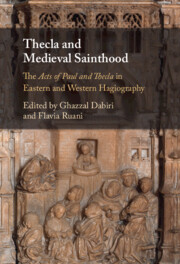Book contents
- Thecla and Medieval Sainthood
- Thecla and Medieval Sainthood
- Copyright page
- Contents
- Contributors
- Acknowledgments
- Abbreviations
- Introduction
- Part I An Act to Follow
- Chapter 1 A Cainite Invocation of Thecla?
- Chapter 2 Saint Thecla in Geʿez Hagiographical Literature
- Chapter 3 Versified Martyrs
- Chapter 4 The Reception of the Acts of Thecla in Armenia
- Chapter 5 Thecla beyond Thecla
- Chapter 6 Shifting the Poetics of Gender Ambiguity
- Part II An Act to Surpass
- Afterword
- Appendix Summaries of Texts
- Index
- References
Chapter 1 - A Cainite Invocation of Thecla?
The Reception of the Acts of Paul in North Africa as Exemplified in Tertullian’s de Baptismo
from Part I - An Act to Follow
Published online by Cambridge University Press: 06 May 2022
- Thecla and Medieval Sainthood
- Thecla and Medieval Sainthood
- Copyright page
- Contents
- Contributors
- Acknowledgments
- Abbreviations
- Introduction
- Part I An Act to Follow
- Chapter 1 A Cainite Invocation of Thecla?
- Chapter 2 Saint Thecla in Geʿez Hagiographical Literature
- Chapter 3 Versified Martyrs
- Chapter 4 The Reception of the Acts of Thecla in Armenia
- Chapter 5 Thecla beyond Thecla
- Chapter 6 Shifting the Poetics of Gender Ambiguity
- Part II An Act to Surpass
- Afterword
- Appendix Summaries of Texts
- Index
- References
Summary
In this chapter, I explore the connections between Tertullian’s de Baptismo, the Acts of Paul, and the supposedly Cainite Gnostic text, the Gospel of Judas. Are Tertullian’s comments concerning both Thecla and Cainites accurate? First, in de Baptismo, Tertullian attacks a Cainite woman for using the example of Thecla as a model to justify women teaching in churches. Further, he criticizes the Cainite woman for denying the practice of baptism within some of the churches of North Africa. Second, the Gospel of Judas—a ‘so called’ Cainite text—seems to affirm the rite of baptism. Do Tertullian’s comments concerning Cainites betray an unfamiliarity with it? Third, in the Acts of Paul, the rite of baptism is affirmed generally, while specifically Thecla is commissioned to teach and even baptizes herself. Why Tertullian would cite the case of Thecla is not clear. How does one synthesize this seemingly contradictory evidence? This chapter focuses upon sorting out these inconsistencies. Ultimately, this chapter demonstrates how some of the churches of North Africa were reading the Acts of Paul as a form of hagiography that was inspiring women in their faith while also impacting their understanding of Christian rituals and practices (i.e., baptism and missions).
Keywords
- Type
- Chapter
- Information
- Thecla and Medieval Sainthood<I>The Acts of Paul and Thecla</I> in Eastern and Western Hagiography, pp. 35 - 60Publisher: Cambridge University PressPrint publication year: 2022

